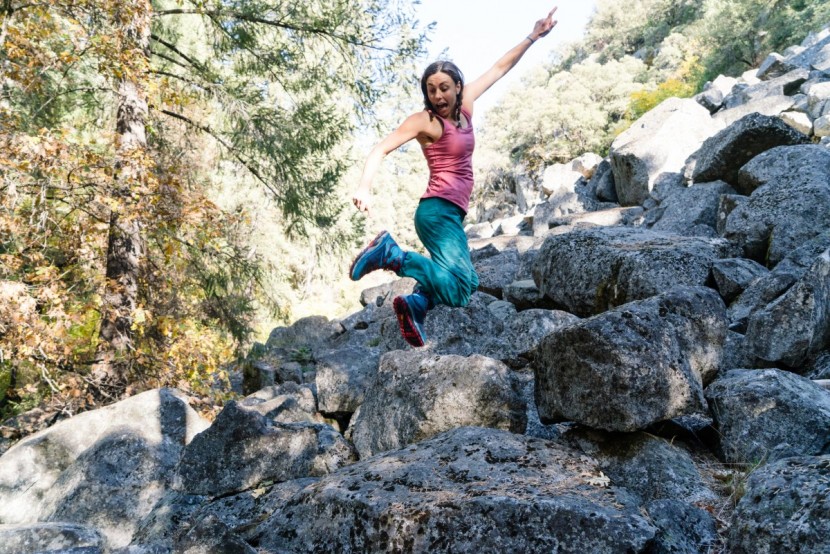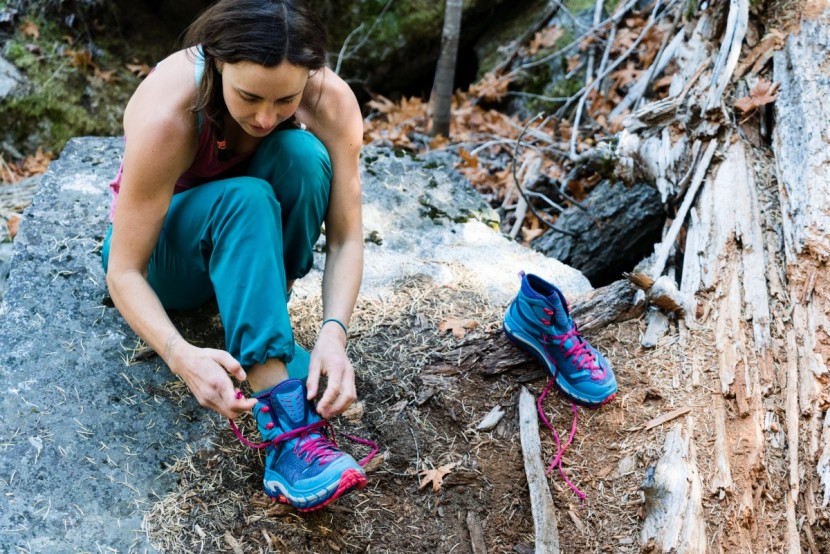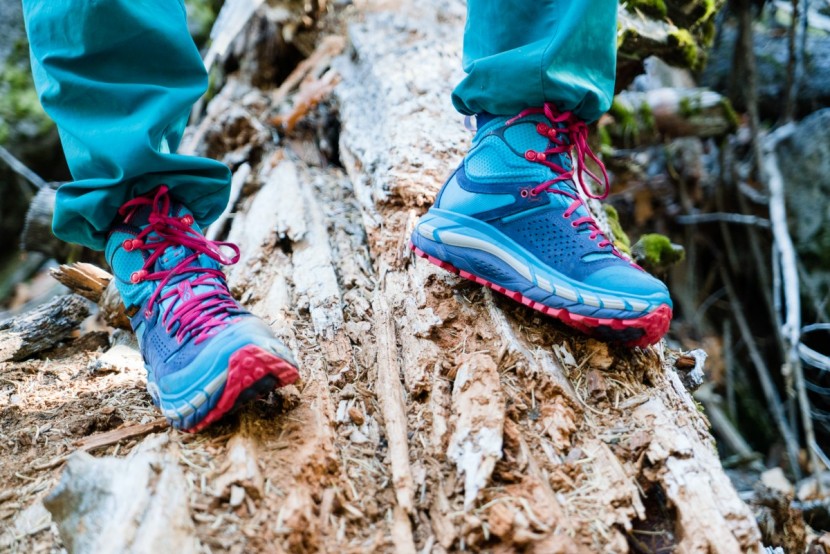From their first moments out of the box, we could tell that the Hoka Tor Ultra Hi was a revolutionary boot. They do not look like an ordinary hiking boot whatsoever. They are HUGE and brightly colored. We were skeptical until we put these boots on and realized their value. These boots have taken six years of Hoka's running shoe technological developments and implemented them to create the most comfortable hiking boot out there. They are the only boot that scored a 10 in comfort on our metrics ratings — no model compared to them in that category. Comfortable feet are key to enjoying the outdoors, and this Top Pick Award-winner knocks that aspect out of the park.
The Hoka's don't slack in other departments either, scoring exceptionally well in all our performance metrics. Getting picky, our testers prefer the nimbleness of the Salomon X Ultra Mid 4 GTX boots, which also strike us as more durable and versatile at a much friendlier price. However, we would never decline a chance to toss on these Hoka's for their cloud-like feels.Hoka Tor Ultra HI - Women's Review
Our Verdict
Our Analysis and Test Results
The comfort and stability that the Hoka Tor Ultra provides make this boot a favorite for long distance hiking or backpacking, while the lightweight running shoe-inspired design makes them an excellent option for day hiking. This revolutionary boot is a fantastic choice for most hiking objectives.
Comfort
Unlike most other hiking boots, the Tor Ultra Hi model has very thick and soft soles. The three components that make Hokas different is what they call the “marshmallow, the rocking chair, and the bucket seat.” The marshmallow is the midsole that is oversized, both in height and width, providing lots of cushion for the foot. The rocking chair is the rocker that is added to the sole, turning both the toe and the heel up a bit, to help maintain an even gait. Finally, the bucket seat is the deep heel cup that keeps the heel in place and adds comfort.
We were skeptical of this newfangled running technology implemented into hiking boots, but the Hoka proved to be comfortable all day long, even on off-trail hikes on rugged, steep terrain. There was little break-in period and no sign of discomfort, even after hours on our feet. The only boots that came close to the Hoka's in terms of comfort were the Salomon X Ultra Mid 4, the Vasque Monolith, and the Keen Targhee III, but the Hokas really take the cake in this category.
Support
The same aspects that added to the incredible comfort of these boots contribute to their supportive and stable nature. At first, there was concern that the height of the midsoles would make these boots feel unstable, but this ended up not being an issue at all. The height of the ankle shaft adds support and prevents rolling.
We wore these boots on steep, technical descents in creek beds and drainages where loose rock, log crossings, and bushwhacking were inevitable, and the Hoka's stood up to the challenge. The Lowa Renegade GTX Mid - Women's also provides plenty of support, but in a more traditional way — stiff sides and a sturdy sole, rather than a lightweight upper and an oversized sole like the To Ultra Hi has.
Weight
Incredibly, these boots weigh only 1 lb 13 oz, though they are the largest boots we tried. They provide the support, comfort, and water resistance that is comparable to an all-leather, traditional hiking boot, but weigh almost 8 oz less than the Lowa Renegade. The boots never felt heavy, even after a full day of hiking.
Traction
The Hoka's have 5 mm lug depths and a thoughtful, aggressive tread pattern that kept us on our feet on the steepest, most rugged terrain. The lugs are well-positioned along the outside of the sole, which adds stability overall. Beyond the tread pattern, it is the rubber that is outstanding on the Tor Ultra's. Hoka uses a rubber compound that rivals some of the stickiest boots out there, as the soft rubber molded to the surface of uneven ground. The Vibram MegaGrip outsoles felt incredibly grippy on boulders, while the tread pattern kept us on track in dirt and gravel.
These boots are on par with the traction of the Salomon X Ultra model, which has a thinner sole that allows for a bit more ground feel, and at times confidence, than this Hoka boot. More aggressive too, they were better at biting into loose and muddy sediment than the Tor Ultra Hi.
Water Resistance
Made with Hoka's eVent waterproof and breathable technology, the Tor Ultra proved to be as water-resistant as its competitors. The uppers are nubuck leather and mesh and appear thin, which allows the foot to breathe, but they are waterproof enough to endure creek crossings and perform in the rain. The height of the sole also helped keep water out in small puddles and streams; the water didn't even reach the fabric of the upper.
Using the same eVent technology as the Hokas, both of the Ahnu boots proved that they are also incredibly waterproof and breathable. The Hokas have not only a water-resistant coating, but they also have super thick soles and a higher ankle height that kept us above the water for most of the creek crossings we encountered.
Durability
During the testing period, the Tor Ultra showed minimal signs of wear. The nubuck and suede leather upper held up on the trail and are what sets these boots apart from Hoka's other running shoes and low weight hiking boots. This leather upper overlays on top of an eVent membrane, giving the boots a feel of durability throughout. We were concerned about wear on the super-sized sole, but during our testing period, the sole showed little sign of wear. In other Hoka models we have tested, though, we have seen signs of the soft midsole chipping away, although it would take a very long time before this would affect performance.
Because of their simpler design with fewer seams and tougher rubber soles, the Lowa Renegade GTX Mid and Salomon X Ultra Mid 4 GTX offer a touch more durability. Their more dense rubber is much more likely to outlast the softer outsole of the Hoka's.
Best Application
For long-distance backpacking, the Tor Ultra performs exceptionally well. The ankle collar keeps water and debris out while stabilizing the foot, making them a good option for snowy, wet, rough terrain. The added cushion and stability from the oversized midsole makes them the most comfortable boot we tried. They also handle well on rugged terrain, so they are great for trips above the tree line. The thick soles don't scramble very well, and when strategic, agile footwork is needed, we'd look elsewhere.
Value
The Hoka Tor Ultra Hi boots cost $230 at full price, making them the most expensive boots that we tested. With boots, though, you do get what you pay for. If you have struggled with pain and discomfort while hiking, the Tor Ultras might be able to fix some of those woes. If that is the case, then these boots are definitely worth the extra few dollars.
Conclusion
Hoka did an amazing job when they created the Tor Ultra Hi. These boots are amazingly comfortable, require no break-in period, and have so much cushion underfoot that knees and hips feel supported all day. The leather and eVent inner membrane provides support along the top of the foot and around the ankle and also keeps water out. The lacing system was well thought out and adds adjustability and support, especially around the lower ankle area. The Tor Ultras held up on rocky, off-trail adventures in the Yosemite backcountry with their grippy rubber soles and smart lug placement. These shoes might have the best chance of keeping your feet fresh on multi-day hikes.










